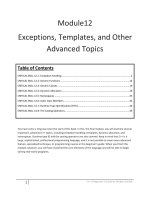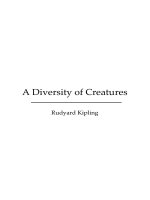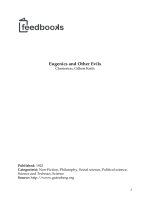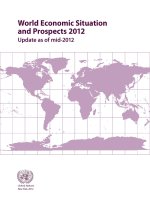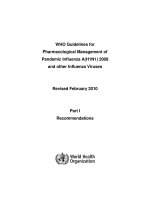Diversity of pest, beneficial arthropods and other non-target biota as influenced by degree of pesticide usage such as indiscriminate, high, moderate and low use situations
Bạn đang xem bản rút gọn của tài liệu. Xem và tải ngay bản đầy đủ của tài liệu tại đây (160.57 KB, 5 trang )
Int.J.Curr.Microbiol.App.Sci (2019) 8(9): 374-378
International Journal of Current Microbiology and Applied Sciences
ISSN: 2319-7706 Volume 8 Number 09 (2019)
Journal homepage:
Original Research Article
/>
Diversity of Pest, Beneficial Arthropods and Other Non-Target Biota as
Influenced by Degree of Pesticide Usage such as Indiscriminate, High,
Moderate and Low Use Situations
B. Thirupam Reddy* and R.S. Giraddi
Department of Agricultural Entomology, College of Agriculture, Dharwad
University of Agricultural Sciences, Dharwad - 580 005, Karnataka, India
*Corresponding author
ABSTRACT
Keywords
Diversity, Simpson
index (D), Pesticide
usage patterns
Article Info
Accepted:
04 August 2019
Available Online:
10 September 2019
Diversity of insect pests influenced by pesticides usages, Simpson index (D) of
biodiversity index of insects were calculated. Significant difference was observed
among the different pesticide usage patterns, and respective unsprayed plots. In
cabbage, D=0.62, D= 0.26 in pesticide and unsprayed plots respectively and
brinjal, D=0.64, D= 0.31 (pooled) were recorded in pesticide and unsprayed plots
respectively where is no significant difference of insect diversity was noticed in
low pesticide usage crops maize D=0.83, D= 0.80 in pesticide and unsprayed plots
respectively and sorghum D=0.88, D= 0.86 in pesticide and unsprayed plots
respectively.
Introduction
Heavy reliance on synthetic fertilizers and
pesticides (insecticides, fungicides, herbicides
etc.) over the last 40 years or so globally and
in India, has been a significant factor in the
decline of invertebrate natural enemy
populations in agricultural systems (Croft and
Brown, 1975; Aebischer, 1991; Berry et al.,
1996). Indiscriminate and high use of broad
spectrum insecticides leads to development of
resistance in insects and ill effects on the
environment. Biodiversity conservation in the
centre of origin is very important and any
threat on this should be eliminated. Thus
before recommending a chemical pesticide to
be sprayed and quantity to be used in any
crop, its impact on insect diversity should be
studied in detail. In recent years, The
Convention on Biological Diversity (CBD)
has recognized predator-prey relationship as a
key driver in the maintenance of biodiversity
and ecosystem functioning.
Capital intensive chemical based production
systems spread by the green revolution in
India were not sustainable and lead to several
environmental problems like replacement of
crop varieties
by hybrids,
declined
biodiversity and environmental resistance.
Due to over and misuse of toxic chemicals in
agriculture, ecocidal consequences viz.,
374
Int.J.Curr.Microbiol.App.Sci (2019) 8(9): 374-378
poisoning of birds, bees, fishes, insecticide
resistance, resurgence, pesticide residues in
food often described as "pesticide treadmill
effects" have been documented (Altieri, 1995;
Sivasubramanian and Wratten, 1995). To
know the effect of pesticides on insect
diversity in different crops were studied in this
research.
Materials and Methods
each plot were observed for shoot infestation.
Thereafter its incidence was noticed at each
fruit picking on randomly selected ten plants.
The number of healthy and damaged fruits on
ten tagged plants was counted at each picking.
The infestation was worked out by following
the standard procedures as indicated below.
Number of drooping shoots
Per cent shoot infestation = -------------- 100
Total number of shoots
Survey was conducted during Kharif and Rabi
2016-17 and 2017- 18 in selected crops in
farmer’s fields and at MARS Dharwad, to
assess the effects of pesticide usage level on
arthropod diversity. Following are the crops
selected for study representing their pesticide
usage levels, Indiscriminate (Brinjal and
Cabbage), high (Pigeon pea and Chilli),
moderate (Soybean and Chickpea) and low
(Maize and Rabi sorghum) under situations of
farmer’s practices. Observations were taken
on pest density and natural enemies on these
selected crops. Standard methods of pest
monitoring mentioned below were followed.
Number of infested fruits
Per cent fruit infestation = --------------- 100
Total number of fruits
Cabbage
During early hours of the day (7 to 9 am)
observations for H. armigera larvae infesting
the crop were taken along the metre-row
length later the total numbers of pods,
numbers of damaged pods per plant were
counted for working out per cent damage.
Lepidopteran insects
Twenty plants samples were randomly
selected at 30, 45 and 60 DAT by using
random row and plant co-ordinates to
determine number of larvae per plant. While
counting of larvae (DBM) it was ensured that
the leaves were not violently disturbed since
the larvae were very sensitive to disturbance
and drop to ground even at slight jerk.
Redgram
Observations on H. armigera were recorded
on 3 randomly selected plants and expressed
as larvae/plant. Leaf webbers were recorded
per plant, while counts of pod fly maggots
were recorded from 5 pods from randomly
selected five plants.
Chick pea
Number of damaged pods
Per cent pod infestation = ---------------- 100
Total number healthy pods
Chilli
Thrips and mites
Brinjal
Incidence of shoot and fruit borer was
recorded at weekly interval during vegetative
stage. The withered or drooped shoots indicate
initiation of shoot infestation. Total number of
plants and number of infested shoots from
Ten plants were brought to the laboratory
(destructive sampling) and later observation
on adults and immature of thrips and mites
were counted from top 3 leaves under
binacular.
375
Int.J.Curr.Microbiol.App.Sci (2019) 8(9): 374-378
Fruit borers
Fruit borer complex viz; H. armigera
(Hubner) and S. litura (Fabricius) larvae were
recorded in the field. In each plot ten
randomly selected plants were used to record
the observations. Larvae of both H. armigera
and S. litura, were counted and expressed as
number of larvae per plant.
The larvae were reared on cabbage leaves in
the laboratory. Emerged parasitoids were
labelled, preserved in clear plastic tubes
containing 90 per cent alcohol. Predators viz.,
coccinellids, spiders and lacewings were
counted in situ and expressed in terms of
population per plant in randomly selected
plants.
Results and Discussion
Maize
Stem borer: To know the extent of damage
observations were recorded on dead hearts at
30, 45 and 60 days after emergence (DAE) on
randomly selected plants.
Soybean
Pod borer
Observations on pod borer, Cydia ptychora
incidence was recorded by uprooting 10
randomly selected plants in each treatment
leaving border rows before harvesting.
Number of pods per plant and number of pods
damaged by the pod borer were recorded and
per cent damage was worked out.
Number of damaged pods
Per cent pod damage = ------------------- 100
Total number of pods
Rabi Sorghum
Aphid: Nymphal and adult populations of
aphids were recorded per cm2 area from 3
randomly selected tender leaves in 10 spots on
each leaf. This was done on 10 plant samples
per plot.
Natural enemy observation
Larvae of the pest were collected and
individually placed in plastic containers (4 cm
diameter 3 cm high) with tight fitting lids.
The results of diversity of insect pests,
beneficial arthropods and other non-target
biota during kharif and rabi 2016-17 and
2017- 18 in selected crops depicting the
pesticide usage situations as indiscriminate,
high, moderate and low are presented as
below. Cabbage and Brinjal were selected
under indiscriminate pesticide usage as these
crops receive highest pesticide interventions
than recommendation. Cabbage with 15-17
sprays in crop period with pesticides such as
Profenofos 50 % EC, Methyl Parathion 50 %
EC and 2 % EC, Carbofuran 3 % G,
Indoxacarb14.5 % SL, Cypermethrin 25 % EC
and 10 % EC, Fipronil 5 % SL, Imidacloprid
17.8 % SL and Spinosad 2.5 % SC. Similarly
brinjal crop also recieves indiscriminate
pesticide usasge with 16-18 sprays with
pesticides such as Profenofos 50 % EC,
Methyl Parathion 50%EC and 2 % EC,
Monocrotophos 36 % SL, Quinolphos 25 %
EC, Carbofuran 3 % G, Carbosulfan 25 % EC,
Fenvalerate 20 % EC and Cypermethrin 25 %
EC.
Under the category of high pesticide usage,
Chilli and redgram were selected. Chilli with
12-13 sprays (Profenofos 50 % EC, Methyl
Parathion
50%EC
and
2
%
EC,
Monocrotophos 36 % SL, Acephate 75 % SP,
Carbofuran 3 % G, Cypermethrin 25 % EC
and 10 % EC, Fipronil 5 % SL, Imidacloprid
17.8 % SL) and Redgram with 5-7 sprays
(Profenofos 50 % EC, Lambda cyhalothrin
5%EC, Quinolphos 25 % EC, Imidacloprid
376
Int.J.Curr.Microbiol.App.Sci (2019) 8(9): 374-378
17.8 % SL, Acephate 75 % SP and
Dichlorovos 76 % EC) under farmers field
situations.
Soybean and chickpea were selected as
moderate pesticide usage crops, with 4-5 and
2-3 spays respectively. Maize and rabi
sorghum were selected as low pesticide usage
crops with 1-2 sprays only used.
To know the diversity of insect pests
influenced by pesticides usages, Simpson
index (D) of biodiversity index of insects were
calculated. Significant
difference was
observed among the different pesticide usage
patterns, and respective unsprayed plots. In
cabbage, D=0.62, D= 0.26 in pesticide and
unsprayed plots respectively and brinjal,
D=0.64, D= 0.31 (pooled) were recorded in
pesticide and unsprayed plots respectively
where is no significant difference of insect
diversity was noticed in low pesticide usage
crops maize D=0.83, D= 0.80 in pesticide and
unsprayed plots respectively and sorghum
D=0.88, D= 0.86 in pesticide and unsprayed
plots respectively (Table 1).
Table.1 Diversity of insect pests influenced by pesticides spray as indicated by
Simpson’s index (D)
No spray
Spray
2016
2017
Pooled
2016
2017
Pooled
D
D
D
D
D
D
Pesticide usage
Crop
Indiscriminate
Cabbage
0.62
0.62
0.62
0.28
0.26
0.26
Brinjal
0.65
0.64
0.64
0.31
0.31
0.31
Chilli
0.68
0.67
0.67
0.53
0.54
0.54
Redgram
0.76
0.75
0.75
0.59
0.58
0.58
Soybean
0.55
0.55
0.55
0.48
0.47
0.47
Chickpea
0.31
0.33
0.33
0.26
0.27
0.27
Maize
0.84
0.83
0.83
0.81
0.80
0.80
Rabi
sorghum
0.88
0.88
0.88
0.86
0.86
0.86
High
Moderate
Low
The present investigation showed that low
pesticide usage patterns did not have any
adverse effect on the natural enemy diversity,
which was measured by using indices of
species richness, diversity and evenness. The
order of Simpson’s index for different
pesticide use situations in crops designated
was of low pesticide > moderate > high >
indiscriminate usage, indicating profound
influence of pesticide usage on insect
communities. Similar findings were noticed
with the work of Dey, 2016 who concluded
that, indiscriminate use of insecticide should
be avoided but the application of insecticide
377
Int.J.Curr.Microbiol.App.Sci (2019) 8(9): 374-378
should be fitted on need based application in
IPM Programme. The insecticide use for the
management of insects should be needed at
low doses, creating no pollution problem yet
effective to the insect and be well fitted in
management tactics without any hazards to
parasitoids, predatory insects, entomophilic
pathogens and pollinators. Firas, 2014 also
reported that, extensive use of pesticides in
agriculture can affect natural enemies, birds
and wildlife (70.19%), contaminate air, soil
and water (66.35%), and cause death to
humans (62.05%). It was also evident from
lower Simpson’s index of species diversity
for sprayed clumps (0.20) and higher for
unsprayed (0.32) in cordomom (Aravind, et
al., 2018). The present findings are also in
line with the earlier observation made by
Kumaresan, (1987) who reported as many as
36 natural enemies on cardamom pests on
cardamom capsule borer itself under low
pesticide usage treatments. Thus, the real
threat on the natural enemies in conventional
ecosystem should be probed and such
chemical components should be eliminated so
as to have a balanced ecosystem with scope
for optimum natural control.
Boulder:Westview Process.
Aravind, J., Samiayyan, K. and Kuttalam, S.,
2018. Assessing the impact of
diafenthiuron 50wp on the pest,
pollinator and natural enemy diversity
in cardamom ecosystem. Journal of
Entomology and Zoology Studies, 6(3):
398-402
Berry, N. A., Wratten, S. D., McErlich. A.
and Frampton, C., 1996, Abundance
and diversity of beneficial arthropods in
conventional and organic carrot crops in
New Zealand. New Zealand. J. Crop
Hort. Sci., 24(4): 307-313.
Croft, B. A. and Brown, A. W. A., 1975,
Response of arthropod natural enemies
to insecticides. Ann. Rev. Entomol., 20:
285-335.
Dey, D., 2016, Impact of indiscriminate use
of insecticide on environmental
pollution. Intern. J. Pl. Prot., 9(11):
264-267.
Firas, 2014, Indiscriminate use and improper
application of pesticides by Jordanian
vegetable and fruit farmers. Bull. Fac.
Agric., Cairo Univ., 65: 344-359.
Kumaresan D, Varadarasan S Gopakumar B.
1987, Review and current status of
research on insect pest control in
cardamom cropping system. J. Coffee
Research, 17:84-87.
Sivasubramaniam, W. and Wratten, S. D.,
1995, Effects of insecticides on the
abundance of arthropod predators in
carrots in Canterbury, New Zealand.
Proceedings of the 48th New Zealand
Plant Protection Conference, 48:
302-307.
References
Aebischer, N. J., 1991, Twenty years of
monitoring invertebrates and weeds in
cereal fields in Sussex. In: The Ecology
of Temperate Cereal Fields (Eds.)
Firbank, L.G., Carter, N., Darbyshire,
J.F. & Potts, G.R.). Blackwell Scientific
Publications, Oxford, UK, pp. 305–331.
Altieri, M. A., 1995, Agroecology: the
science of sustainable agriculture.
How to cite this article:
Thirupam Reddy, B. and Giraddi, R.S. 2019. Diversity of Pest, Beneficial Arthropods and
Other Non-Target Biota as Influenced by Degree of Pesticide Usage such as Indiscriminate,
High, Moderate and Low Use Situations. Int.J.Curr.Microbiol.App.Sci. 8(09): 374-378.
doi: />378

